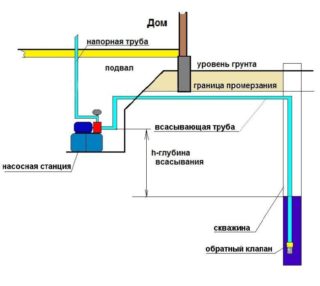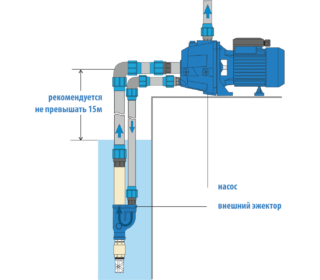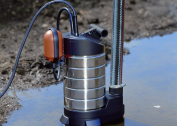Pumping stations have increasingly been used for autonomous water supply systems, in which water intake is organized from wells, wells or open water bodies. Pump units are selected according to three parameters: suction depth, capacity, pressure. The maximum suction depth of the pumping station is the ultimate indicator by which the units are selected.
Suction depth
There are two types of NS, which differ in the presence or absence of an ejector. The latter is a kind of additional pump (without an electric motor), with the help of which the possible depth of intake is increased.
Passport depth of absorption, as a rule, is - 8 m. This is provided that there is no ejector in the configuration of the station. If this device is present in the water intake system, the indicator may increase. Manufacturers offer pumping stations with a built-in ejector. Practice has shown that such installations are quite moody. Not always with their help you can raise water from the wells of the declared depth.
A better location is a remote ejector. It is installed at the end of the intake hose (plastic pipe or rubberized hose), where it is fixed with a plastic clamp. But this design reduces the efficiency, because for the operation of the ejector requires a certain speed of water. The pump lifts the liquid to the surface, part of it drives back to the ejector through a parallel pipeline. The movement of water, first up and then down, reduces the efficiency of the pump unit.
The suction depth of a station with a built-in ejector is not more than 9 m. With a remote - not more than 10.5 m. On many sites there is an indicator of 45 m. This is misinformation. The NS has several technical characteristics, where 45 meters is the maximum distance from the water mirror inside the well to the last consumer in the autonomous water supply network. The indicator often appears in the passport data, but it is not the only one. In the market you can find stations for which this distance exceeds the indicated value.
Water Rise Indicators
In the NS passport, the manufacturer always indicates the maximum values of technical characteristics. When buying equipment, it is necessary to take into account the ratio of these characteristics with the technical indicators of the water supply system of the house. If the station is incorrectly selected for the water supply, it is likely that the latter will not work correctly. For example, there will be insufficient water or pressure will be weak.
In the product passport, the manufacturer must indicate the graphical dependence of all characteristics among themselves. With it, you can see the dependence of the pressure, flow rate of the installation to the characteristics of the water supply system. On its basis, the buyer can independently choose the model of the pumping station, taking into account the indicated characteristics and suction depth.
How to calculate the required suction depth of the pumping station
 To calculate the technical characteristics of the station, information is needed regarding autonomous water supply:
To calculate the technical characteristics of the station, information is needed regarding autonomous water supply:
- The distance from the water mirror in the well to the consumer who is in the farthest point in the water supply network. Moreover, the distance consists of all sections, because the network is usually not straightforward. The more branches, the greater the loss of pressure and flow.
- The distance from the pumping station to the water intake point. The equipment can be installed near the well, in the basement of the house or in a specially constructed room.The farther the station’s location, the greater the loss, the less the suction depth.
- Number of fittings and valves. Here you can take a 10 percent margin of all the characteristics - pressure and pumping station capacity.
- Dynamic water level in the well. This value varies depending on the season and water intake intensity. It must be taken into account when calculating the depth of absorption. It is necessary to know that the end of the suction pipe should be located at least 1 m below the water mirror. If the dynamic level is large, it is likely that in the summer season the water in the well drops below the installation level of the end of the suction pipe.
- The diameter of the pipes used in the plumbing system.
- The number of consumers.
The dynamic water level in the autonomous water supply system plays one of the most important roles. If you neglect its value, you can forget about the characteristics of the water supply network.
The largest losses of water pressure inside the water supply are vertical. The depth of absorption affects the characteristics of the water supply. The larger it is, the more proportionally the performance decreases. For example, if the indicator is 8 m, the pressure loss is reduced by 0.8 bar.
To combat a decrease in the depth of water intake, a caisson is installed above the well. This is a special cylindrical or cubic shaped container, which is instilled to a certain depth. They mount the NS. The greater the caisson height, the lower the pump will be located. Thus, it is possible to reduce the installation location of the spread station and reduce the distance from it to the water mirror.
There is one more option. A metal structure assembled from a metal profile (usually a corner or channel) is installed inside the well. It is attached to the walls of a hydraulic structure. A pump station is mounted on this support. To ensure higher characteristics of the water supply network, the support structure is lowered to the level of the water surface in the well. The inconvenience of such an installation is that the station is located at a great depth, which means it will not be easy to monitor and maintain it.



